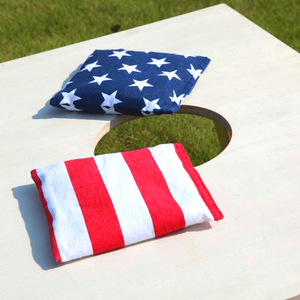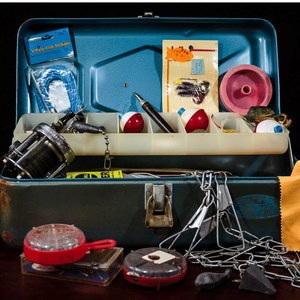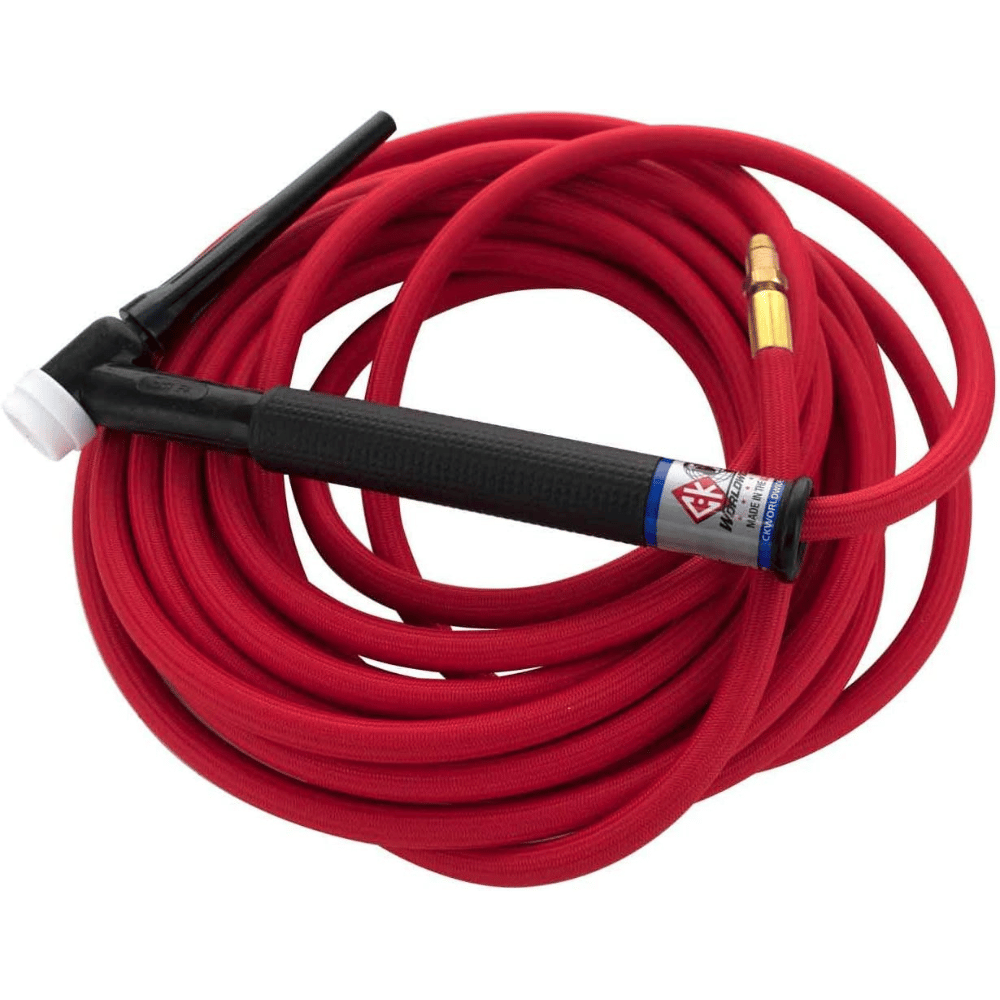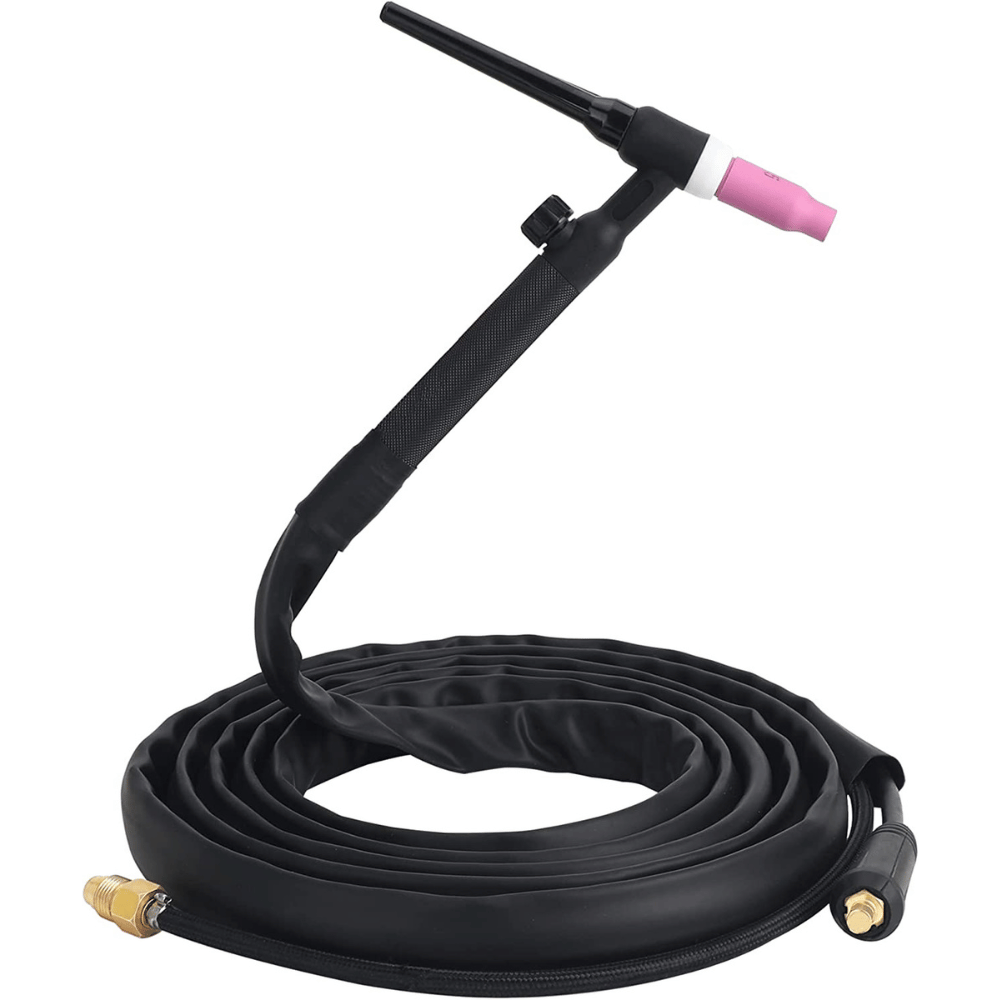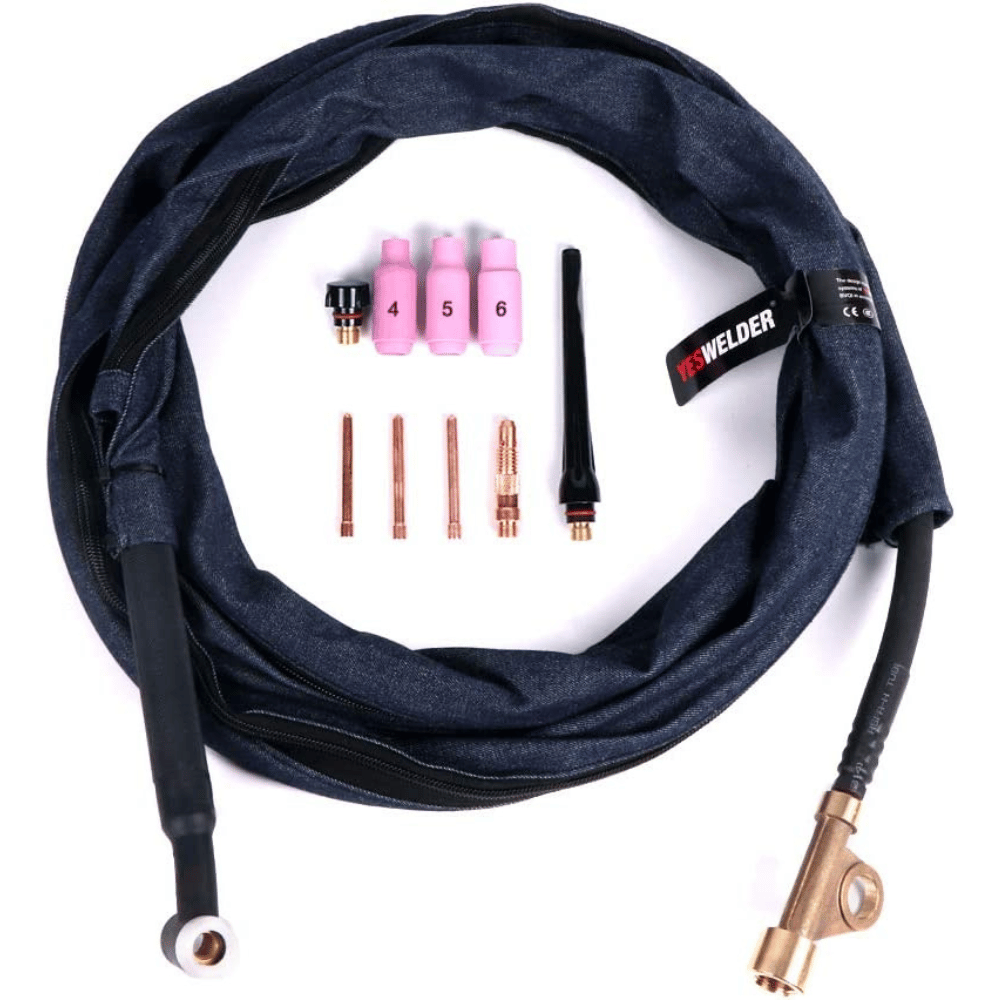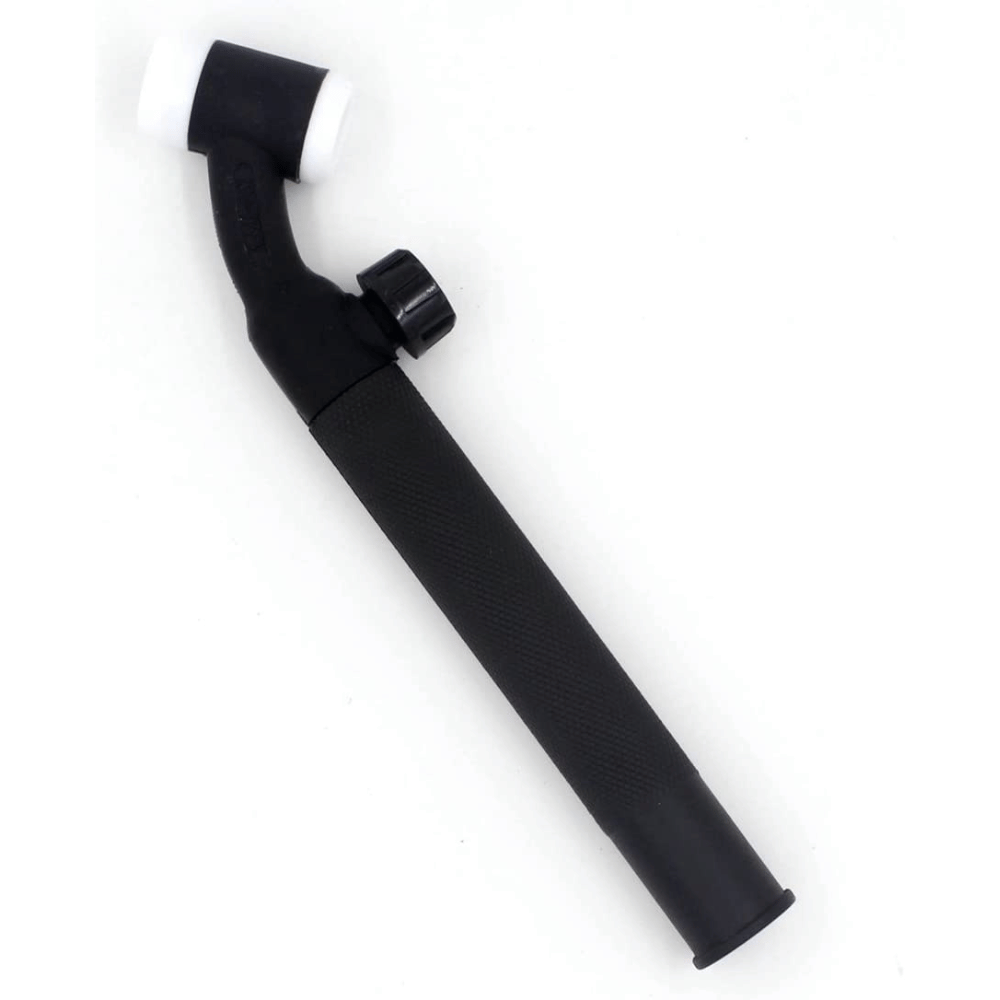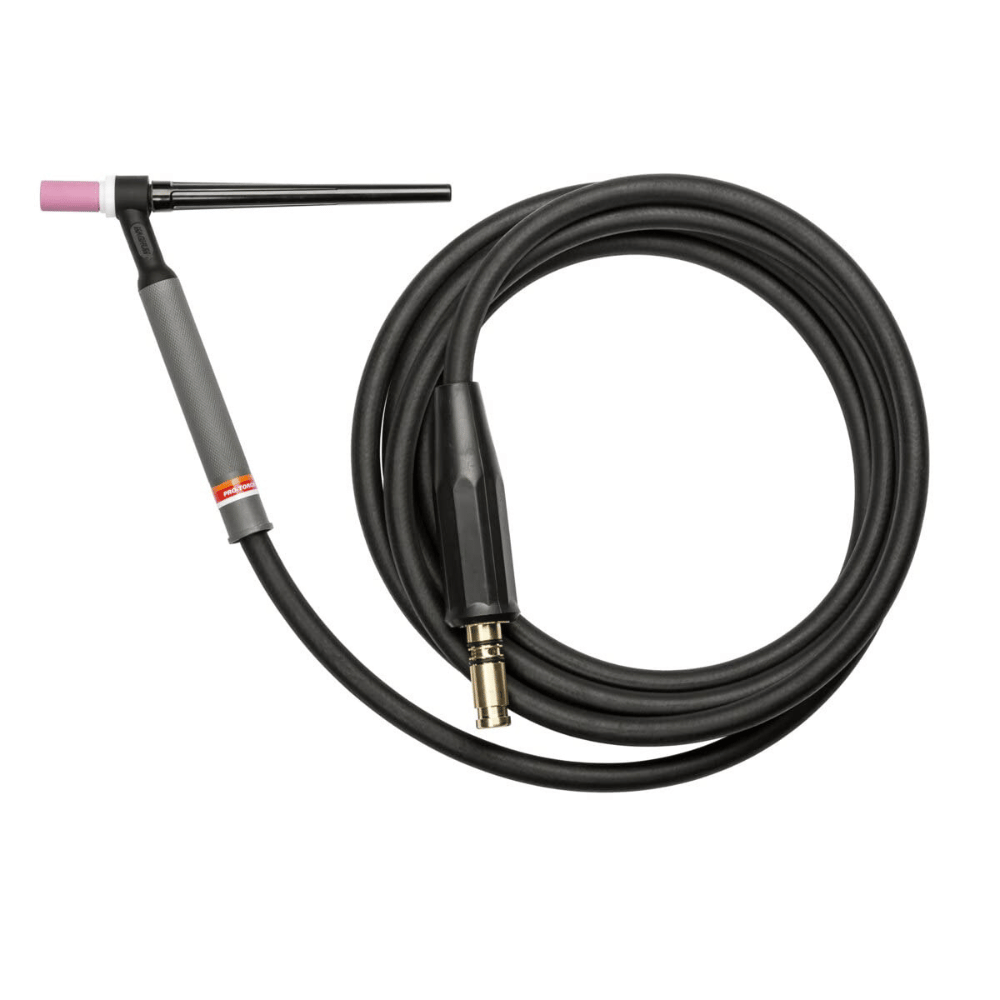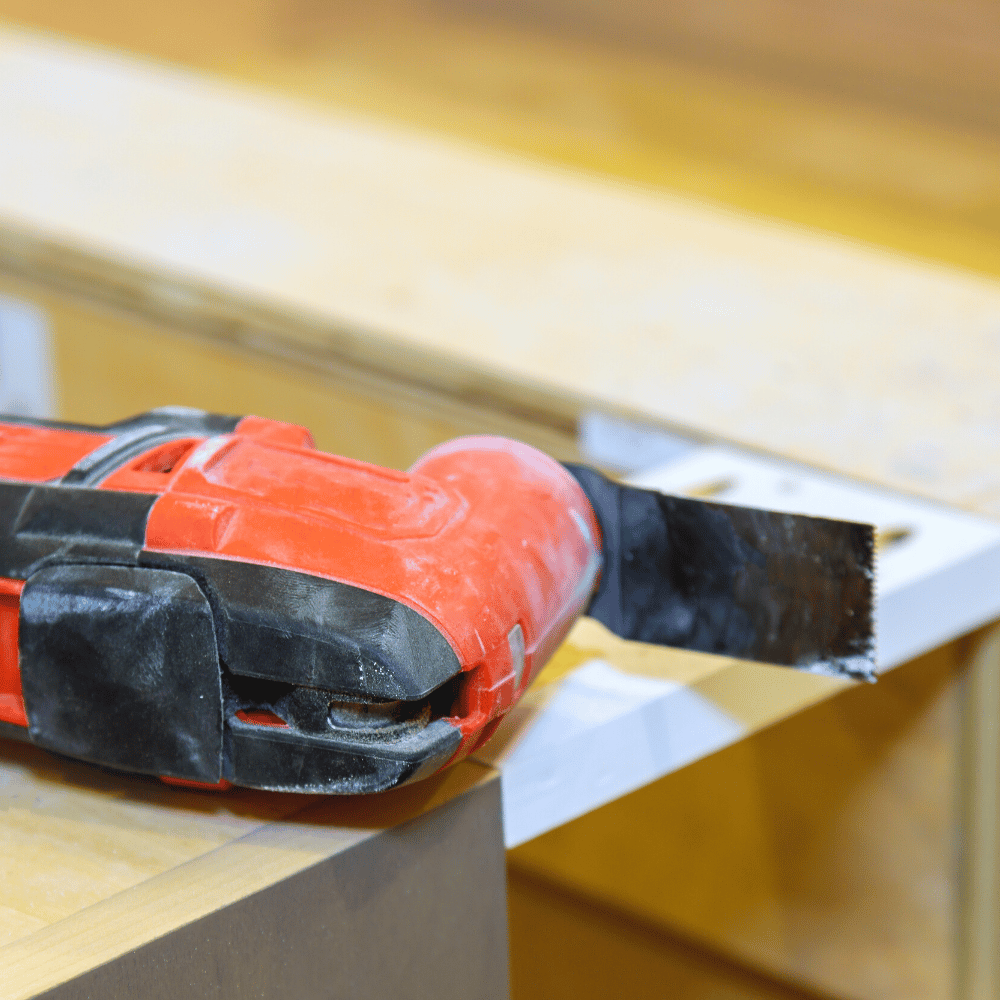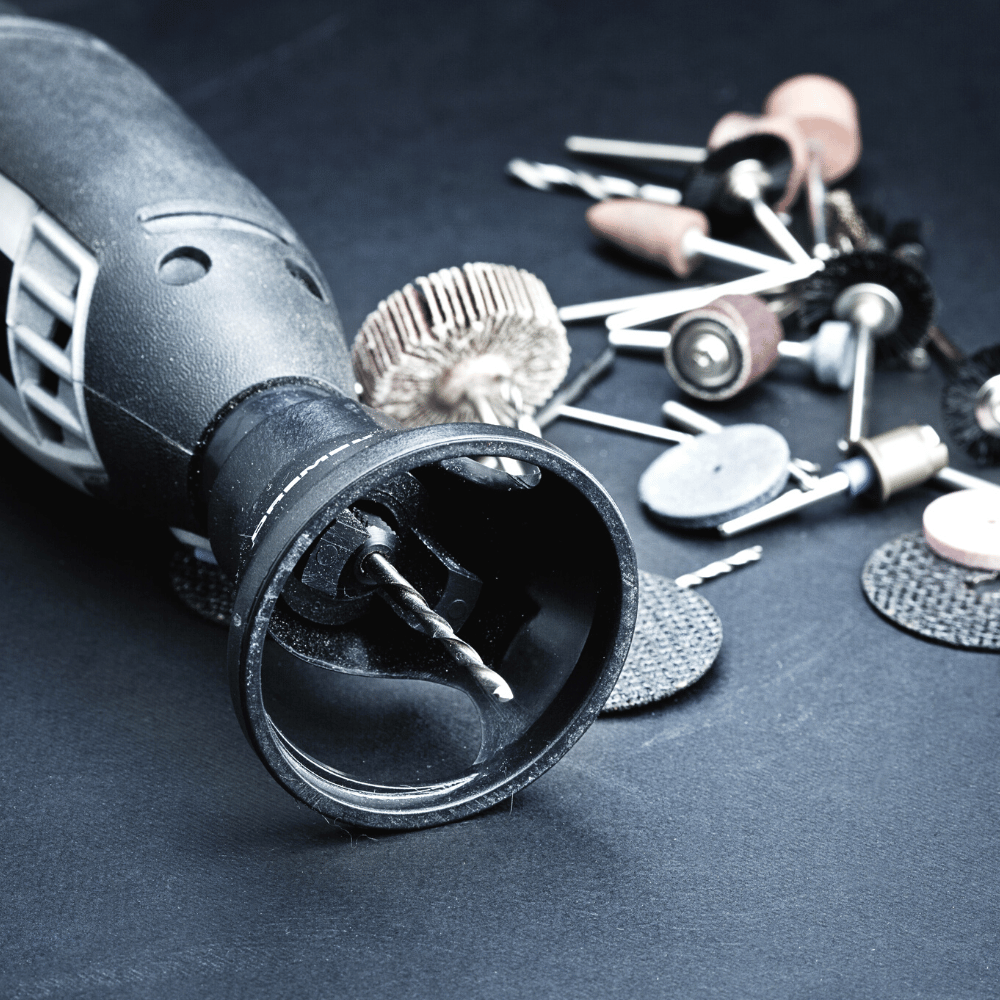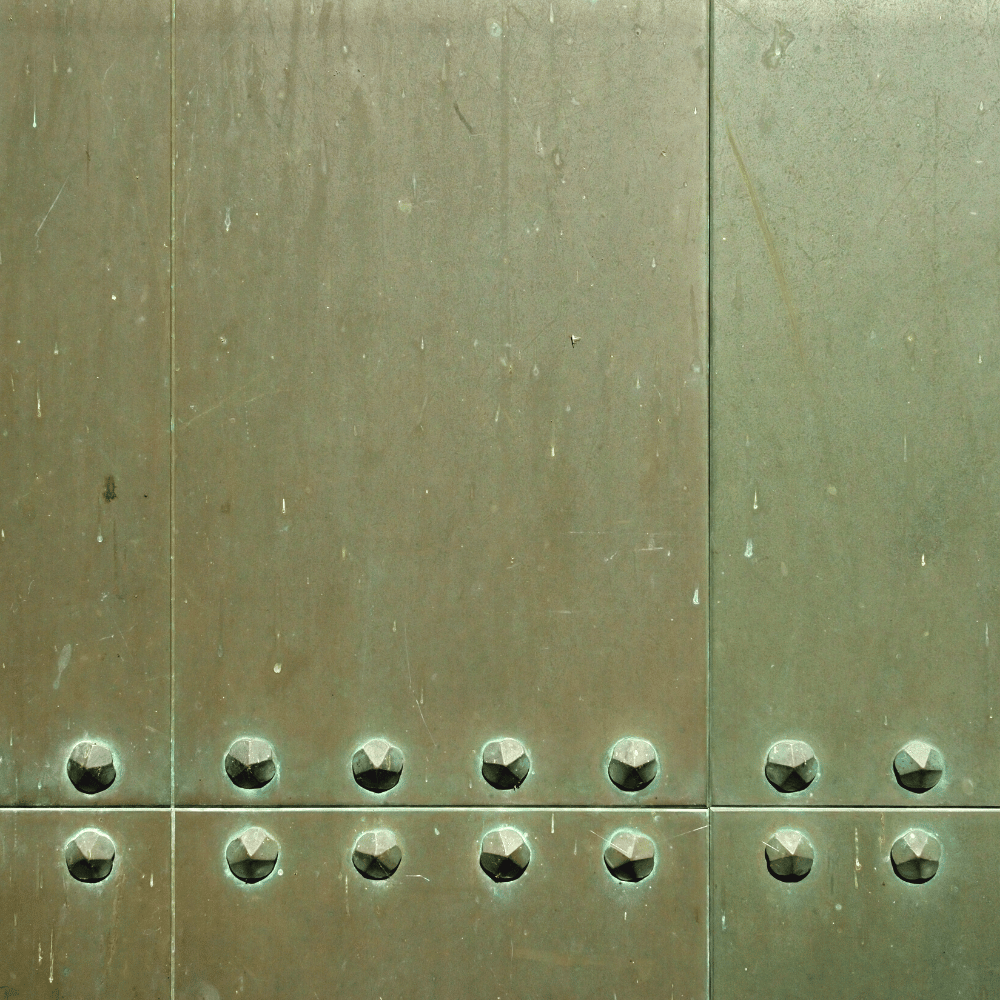The TIG (Tungsten Inert Gas) welding process requires precision and control, making the right TIG torch essential for a successful weld.
A high-quality TIG torch allows for better arc control and delivers consistent heat to the work piece, resulting in smoother and stronger welds. With various models like water cooled TIG torches available in the market, choosing the best TIG torch can be overwhelming.
In this article, we will explore the key features to consider when selecting the TIG torch that best fits your welding needs.
TOP SHELF SUMMARY
- Top Shelf - CK17 Air Cooled TIG Torch Kit
- Next Best - Lift TIG Torch Air Cooled Argon Welding Torch
- Editor’s Choice - YESWELDER Tig Welding Torch
- Consumer Favorite - WeldingStop TIG Welding Torch
- Splurge Worthy - Lincoln Electric PTA-9 Ready to Weld TIG Torch
Why You Should Use TIG Torch
The TIG welding process requires a high degree of control and precision, and the TIG torch is a crucial element in achieving this. Whether you are working on a project that demands precision or need to produce high-quality results, a TIG torch is an indispensable tool.
The TIG torch gives the welder greater control over the arc, resulting in clean and precise welds. Additionally, TIG torches can be utilized on a variety of materials, including stainless steel, aluminum, and copper alloys. The TIG welding process yields strong and pristine welds, with little to no warping or discoloration of the work piece.
TIG welding is also relatively safe, with features such as cooling systems built into the TIG torch to minimize risk. To sum it up, the TIG torch is essential for any project that requires control, precision, and high-quality results.
How We Picked The Best TIG Torch
When selecting the best TIG torches, we looked for torches that were made from high-quality materials, had an ergonomic design, and offered a wide range of features that would make welding easier and more efficient.
We also considered customer reviews to determine which torches had the best features and user satisfaction. We sought out air cooled torches that could be used for a variety of welding applications and that were compatible with a wide range of welding machines.
TOP SHELF
TOP SHELF FEATURES
The CK17 Air Cooled TIG Torch Kit features a Flex head that can be adjusted up to 40 degrees from centerline for improved accessibility and maneuverability. The Super-Flex cables are made of durable silicone hose with a nylon over-braid, offering a lightweight and flexible design that stays flexible even in tough conditions.
The kit includes 3 Series Head Accessories for added versatility and convenience. These features make the CK17 air cooled tig welding Kit an ideal choice for TIG welding professionals who require a durable, flexible and versatile torch, this one is consider best Tig torch for pipe welding.
TOP SHELF DETAILS
The CK17 Air Cooled TIG Torch Kit has a compact and lightweight design, with a total weight of 5 ounces (141 grams) and dimensions of 12 inches x 6 inches x 4 inches (LxWxH). The torch measures 8-1/8 inches (20.6 cm) in length, making it easy to maneuver and handle in tight spaces.
Despite its small size, This air cooled torch Kit is a powerful tool, offering excellent performance and durability. Its compact design and lightweight construction make it an ideal choice for TIG welding professionals who need a portable and easy-to-use torch.
Next Best
TOP SHELF FEATURES
The Hynade Lift TIG Torch is a high-quality TIG welding torch that offers several key features. With a capacity of 150 amps and a 13-foot cable, it's ideal for welding on thin to medium gauge materials.
It comes with a quick connector that can accommodate cables ranging from 10-25mm² and is compatible with electrode sizes ranging from 0.5-2.4mm. This TIG torch boasts maximum DC amperage of 140 amps and maximum AC amperage of 125 amps, providing reliable and consistent results. The lift tig lift arc function facilitates the initiation of TIG welding and enhances control during the welding process.
This TIG welder gun is a suitable replacement for several mainstream welders including the HB Mig 200, Mig 250, MT2000, HBM 1200, Warfox ST200D, and Hynade MTG155D MTG165D MTG165SG MTG175SG.
TOP SHELF DETAILS
The Hynade Lift TIG Torch is a TIG welding torch that is both compact and lightweight, making it easy to handle and maneuver during welding tasks. The package includes the torch itself, as well as important components like three ceramic cups, three collets, a 2.4mm collet body, a long back cap, and a short back cap.
Some parts come pre-installed on the gun, streamlining the setup process. Weighing in at just 2.86 pounds, this TIG torch is a versatile and reliable tool suitable for a variety of welding projects.
Editor’s Choice
TOP SHELF FEATURES
The YESWELDER Tig Welding Torch features a power/gas cable connection of 3/8"-24 RH with a 105Z57 adapter, making it compatible with standard TIG consumables and parts.
The air-cooled tig welding torch design ensures a longer service life for the torch, allowing for long-term use. The torch head has a flexible and valve style, providing versatility in welding applications.
TOP SHELF DETAILS
It is a lightweight tool, weighing only 2.83 pounds. It comes with a variety of accessories to enhance its functionality, including three different sized alumina ceramic cups with orifices of 1/4", 5/16", and 3/8" respectively.
It also includes collets in various sizes (1/16", 3/32", and 1/8") and a collect body of 1/8". The back cap options include a long and a short version (57Y02 and 57Y04). These accessories ensure that the YESWELDER TIG Welding Torch can be used in a wide range of welding applications
Consumer Favorite
TOP SHELF FEATURES
The WeldingStop TIG Welding Torch is a high-performance tool with a 17fv tig torch that has a flexible head. The head is attached to a lightweight handle with a non-slip grip, providing comfort while in use.
The torch is designed with air cooling, increasing its durability, and has a gas valve on the WP17 torch head to control the flow of air. This torch can be utilized in TIG welding processes with amperage of up to 150 amps. As part of the TIG torch 17 series, the WP 17 torch is well-regarded for its flexible head and air valve, making it a popular choice for welding professionals.
TOP SHELF DETAILS
It has a lightweight design, weighing only 4.2 ounces. This tig torch body from a combination of materials including copper, rubber, and plastic, ensuring durability and longevity. The torch does not require any batteries, making it convenient and easy to use.
With its combination of lightweight design and high-quality materials, the Welding Stop TIG Welding Torch is a reliable and efficient tool for welding professionals.
Splurge Worthy
TOP SHELF FEATURES
The Lincoln Electric Weld TIG Torch is engineered for precision and comfort during welding. It has a knurled handle that offers a secure and non-slip grip, enabling better control in welding operations.
The torch is compatible with industry standard TIG expendables, making it effortless to integrate into existing welding setups. The torch is available in several specialty models, including those with flexible heads, gas valves, and ultra-flex cables, which cater to diverse welding applications and allow the user to choose the right fit for their project.
With multiple sizes and amperage ratings, the Lincoln Electric Weld TIG Torch is versatile and suitable for use in a variety of welding situations.
TOP SHELF DETAILS
The Lincoln Electric Weld TIG Torch is a top-quality welding tool with a package weight of 3.0 lbs. It features a rigid tig torch head with a length of 12.5 FT and a 1 piece cable.
The product dimensions are 11.3 x 12.7 x 2.3 inches, making it compact and easy to handle. The torch is lightweight at 3 pounds, allowing for effortless use during long welding sessions.
Best TIG Torch for You
The best TIG torch for you will vary based on your specific needs and preferences. When choosing a TIG torch, consider factors such as the size and weight of the torch, the length of the cable, and any additional features such as adjustable amperage control or a digital display.
By carefully considering your options and selecting a high-quality TIG torches, you can ensure that your welding projects are completed with precision and ease.
Click or tap the buttons to check the price on the right TIG torch for you!
TOP SHELF RECAP
- Top Shelf - CK17 Air Cooled TIG Torch Kit
- Next Best - Lift TIG Torch Air Cooled Argon Welding Torch
- Editor’s Choice - YESWELDER Tig Welding Torch
- Consumer Favorite - WeldingStop TIG Welding Torch
- Splurge Worthy - Lincoln Electric PTA-9 Ready to Weld TIG Torch
TIG Torch FAQs
Here are the most frequently asked questions about the best TIG torches:
What is a TIG torch used for?
A TIG (Tungsten Inert Gas) torch is an essential tool in a variety of welding operations and processes. It uses an arc welding process to join two or more materials together, often metals, with a filler material – like aluminum, stainless steel, copper alloys and titanium – to form a single piece.
The most important part of the TIG torch is the tungsten electrode; this is usually made of tungsten alloy wire that’s heated through electric current to produce the arc that melts the filler material. The helmet protects your eyes from the extremely bright light produced by this process.
When it comes to specific uses, one primary benefit of using a TIG torch is its ability to be used on thin sheet metal welds in many industries like automotive and aerospace manufacturing. It produces very precise welds with minimum distortion because it allows for more accurate control over heat input than other welding processes. The high level of accuracy also makes it well-suited for delicate tasks like jewelry making and intricate repair work.
It’s also often used when creating pressure vessels such as boilers - these are highly regulated components within industrial systems so any imperfection can cause serious safety issues further down the line!
Another great advantage of using TIG torches is their ability to give you higher quality welds than you could get with some other methods due to its control over current strength - lower currents can be used without risking porosity while still getting strong joints between metals which would otherwise not bond easily together! This means that even if there are gaps between parts being joined they may still turn out successfully via careful adjustment of parameters - something almost impossible with conventional MIG/MAG techniques!
In conclusion, while other techniques might have faster cycle times compared to those achievable via TIG techniques (especially on thicker sections) their lack in precision means they shouldn't be considered when producing complex parts or working carefully around smaller details requiring greater attention - meaning there's always going to be value for money invested in having accesses advanced tools available such as those provided by a reliable supplier offering comprehensive solutions related specifically towards automated applications involving ARC & GAS WELDING technologies from start until end production results!
Is TIG better than MIG?
TIG (tungsten inert gas) and MIG (metal inert gas) are two common types of welding that both offer advantages. Ultimately, whether one is better than the other depends on your specific needs and the individual project you’re working on.
To start with, let’s compare TIG to MIG in terms of benefits and drawbacks. TIG is generally preferred for delicate welding jobs due to its high accuracy and precision. With this type of welding, a separate filler rod isn't necessary since it relies only on the heat generated by an arc between a non-consumable electrode and base material; all that's needed is an argon or helium mix as a shielding gas. This makes it great for small joints at precise angles. On the downside, however, TIG requires more skill to operate than MIG does – making it better suited for experienced welders who want greater control over their workpieces' quality.
In contrast, MIG uses metal wire as the filler material which gives it much faster speeds than TIG while still allowing reasonably precise welds if used properly; but these fast speeds also come with some compromises in terms of finer details and overall aesthetics when compared to what a skilled welder can do with TIG technique. However, even entry-level workers can become competent with MIG easily after minimal instruction since its main advantage lies in its simplicity; so if speed is key then this could be your best choice regardless of experience level or required results.
Other considerations include price: both welding techniques have similar costs associated but because fewer materials are required for a proper setup (such as no additional rods), prices tend towards favoring light industrial applications using either method over heavier use cases like shipbuilding or automotive manufacture which may require more resources from users who don't know how/when best employ each type—such knowledge typically comes from lengthy practice though.
So as you can see there's no simple answer here: depending on what kind of job you're doing (and how long you want/need it take!) different pros & cons should be weighed when considering whether one type might be better suited than another – ultimately leaving up to good judgement call made by yourself (or supervised by someone trained enough!).
What is the easiest metal to TIG weld?
From a welding standpoint, the easiest metal to TIG weld is aluminum. Aluminum has a relatively low melting point, making it much easier to work with than other metal alloys such as steel or stainless steel. Plus, an experienced welder can control the aluminum's heat more precisely since it heats up quickly and cools off quickly too.
But that doesn't mean other metals don't have their advantages when it comes to TIG welding - some metals may be easier for specific projects depending on your skill level and experience. For instance, mild steel is generally more forgiving when it comes to weld imperfections like porosity (tiny holes in the weld caused by air getting trapped inside) as long as you use the proper settings on your machine and maintain good contact between the joint surfaces. When it comes to stainless steel, because of its higher melting temperature, you can often get away with using a higher amperage setting which produces less splatter at lower temperatures while still having high penetration properties.
In conclusion - while aluminum may be one of the most popular choices simply due its ease-of-use when welding thin materials - just remember that other metals will offer different benefits depending on what type of project you're working on!
Is TIG welding hard?
TIG welding can seem intimidating, but it’s really not as hard as you might think. Just like any type of welding, there will be a learning curve and some practice is needed before you start getting great results.
In the TIG process an arc is formed between a tungsten electrode and the metal being welded. Argon or helium inert gases are used to provide protection from atmospheric contamination during the welding process. The welder then slowly adds filler material to complete the weld joint. This type of welding joins metals requiring high levels of heat and precision so it's typically used for thin metals that require clean weld beads that look neat and professional when completed.
One advantage of TIG welding is its portability since it runs on electricity instead of fuel tanks like other types of arc welders do; plus, with TIG there aren't any big sparks or noxious fumes so you don’t need additional ventilation equipment around your work area either! Additionally, some materials such as stainless steel are easier to join using this process than with others because TIG allows better control over how much heat is applied at once which helps prevent warping or annealing while joining two pieces together quickly and safely.
The biggest challenge with this technique comes from trying to keep up a steady hand—which takes time to master—but if you have reasonably good hand-eye coordination anyone should be able to achieve satisfactory results in relatively short period time!
Can you cut metal with a TIG torch?
TIG welding is a versatile and very popular process used to join many different types of metals. It’s one of the most popular processes because it creates strong, clean welds with minimal heat distortion and can be applied to a wide variety of applications.
TIG welding is an ideal choice for cutting metal as well, since you can use the same equipment with small modifications. The process works by using heat from an electric arc formed between a non-consumable tungsten electrode and the workpiece to melt holes in thin or thick steel materials. By manipulating the torch angle, speed, distance from material, current setting on power supply unit and type/size filler rod being used you can control how much material gets cut away per pass resulting in accurate cuts that create clean edges.
The ability to precisely control your arc allows for smoother finish compared to other methods such as plasma cutting which tends to have more burn marks after its finished cut passes due its higher amperage rates. This fact makes TIG especially suitable when working with thin metals where accuracy matters most.
Additionally because you don't need fuel like oxy-acetylene torches or plasma cutters do it's also far safer when dealing with high risk projects such as near combustible materials as these could cause dangerous explosions due escaping fumes under certain conditions if extreme caution isn't taken while operating unventilated areas.
It should be noted however that while this method will produce good results once you’ve mastered technique it doesn’t make light work out of heavy cutting jobs which would require more specialized equipment—such as water jet cutting—but should work perfectly fine for any day-to-day operations requiring precision detailed cuts of metal objects!



